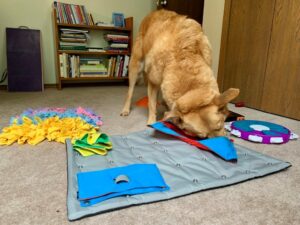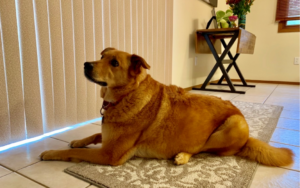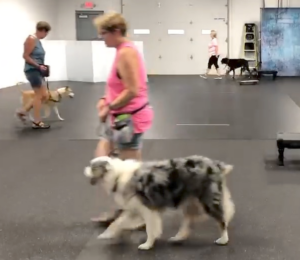Barks Blog
Portland Blog Competition: May I Speak to the Manager?
By Tina Ferner

Last week, I received a voicemail that a trainer NEVER wants to hear. It went like this, “Tina, this is Eileen. Dolly just killed Miley.” Dolly was a rescued mixed breed dog that weighed approximately 65 pounds while Miley was a Maltese mix that weighed 8 pounds.
There had been problems in the past with resource guarding and several “scuffles” between the two dogs. After our initial consultation, Eileen and I had mapped out a management plan. This plan involved leashes, gates, crates and securely closed doors. I also recommended that the two dogs be kept completely separate due to the body language that she observed when they were in the same room albeit secured by a leash or gate.
Management is an essential piece of living with an aggressive or fearful dog and it can be lifesaving. An important component of my Reactive Dog Protocol is management. I have had 200 teams graduate using this protocol and many have gone on to join our so-called “Normal” group classes and even have earned their Canine Good Citizen or are competing in various dog sports. They could not have done this without a successful management program.
What do we mean by management? It is different for each family, but contains common threads throughout. The two main goals of management (aka antecedent control) are safety for all, including the reactive dog; and to reduce cortisol levels in the dog and help produce relaxation. We look at a comprehensive sensory approach and do what we can to involve all the dog’s senses to generate an overall relaxation response.

Visual Aids: This means creating visual barriers to block the dog’s view of the outside world while in the house, out in the yard or riding in the car. If the dog reacts when looking out certain windows, block the view by keeping blinds drawn, gating off that room, or applying frosted, decorative decals that are “dog height” to impede his view. Traveling with your dog in a covered crate in the car will prevent reactions out the window. Accompany your dog outside or schedule only brief outside sessions to prevent the dog from reacting to outdoor stimuli.
Auditory Aids: For dogs that are sound sensitive it is a good idea to play background music especially while you are away. There are specially formulated CDs to enhance relaxation as well as a collar that plays soft, calming tones.
Olfactory Aids: Dogs have 220 million scent receptors compared to 5 million in humans. Their sense of smell is essential to the way they discover their world. Using calming sprays, diffusers or better yet, collars and bandanas is a great way to enhance calmness. Products that use dog pheromones can produce a calming effect on the dog. My favorite way to induce this is through a collar or bandana sprayed with one of the calming products.
Nutriceuticals and Pharmaceuticals: There are an assortment of herbal supplements and medications available that help promote relaxation. Consult with your veterinarian for their recommendations. There have been specific types that have worked very well with my clients and have created significant behavior change in their dogs.
Gustatory Aids and Enrichment: There are many ways to satisfy a dog’s hunger while engaging his mind, which will result in tiring his body. A few examples that work well for my clients: Food puzzles, foraging and scent exercises, or a stuffed, frozen Kong.
Exercise: Exercising the body is a very important component to creating a calm dog. If the exercise cannot be done on walks due to the dog’s reactivity, indoor exercise games can be created out of ordinary household items and even treadmills can be used for this purpose.
Body Work: Massage, energy work, reflexology can be done on the dog to help relax him. I teach my clients some simple yet powerful techniques to perform on their dog.
Other Forms of Management: Management can also look like a double barrier system near the door to prevent a dog from door-dashing. Keeping the dog leashed while exiting the car, even if it is just between the garage and the house, to be sure the dog does not dash out the door or away from you. Management can also include having your guests text you prior to arrival so that there is time to confine the dog behind a closed door. Again, a stuffed Kong or other food toy can work wonders here and keep your pup mentally stimulated and, therefore, less likely to become emotionally aroused. This will ensure guests stay safe and the dog is not pushed over his threshold to react. Another form of management is to perform a “pre-flight check” prior to walking your dog to be sure the harness or collar and leash are fit snuggly and securely in case there are any triggers that the dog encounters on the walk.
In the case of dogs that do not get along inside the home, management can include separating them at all times by gates, crates or closed doors depending on the severity of the aggression and the severity of fights, bites and injuries.
I counsel my clients to incorporate an impeccable management protocol into their lives. At first it may seem overwhelming and it certainly has an impact on the routines of the household, but after a while it can become a seamless integration into the home. Impeccable management is more difficult to carry out in households with multiple people and schedules. It is imperative that everyone in the household is on board with the management protocols that are in place so that the management system does not fail.
When Management Fails
Back to my client Eileen, who had put Dolly behind a closed door and went out to bring the trash cans in from the curb. As she approached the house, she heard screaming and growling. She dropped the trash cans, ran into the house and saw Dolly shaking Miley with blood splattered on the wall. She was able to separate the two and rush Miley to the vet, but unfortunately Miley passed away on the way to the vet. After this devastating occurrence and loss, Eileen was now faced with having to euthanize Dolly. This was also a devastating loss as she had grown to love Dolly and had progressed to an advanced level with their training skills. The amount of time and resources she had committed to Dolly had created a deepening bond between the two which made this decision even more difficult. The options were non-existent for Dolly as Eileen had another little dog at home and could not risk keeping Dolly while putting the other dog in danger. Relinquishing Dolly would only result in euthanasia at a shelter. The next day Eileen accompanied Dolly to their veterinarian’s office where Dolly’s life was peacefully ended. In the end, management failed. Eileen thought back on all the events and realized that she had not latched the door when she went out, thinking she was going to be out only for a couple of minutes.
I cannot stress enough how important impeccable management is. The result of management failure can be devastating. Unfortunately, many clients don’t realize it themselves until management fails. I have plenty of stories to tell that illustrate the devastating loss when management fails. These prompt us to create a secure management plan.
Another client, Susan, has a dog reactive pit bull named Wanda. Wanda has made wonderful progress in training class but is still reactive. This dog is a door dasher without, yet, good recall.
Susan was taking a few things from the front door to the car and left the door ajar as she was only going to be out a couple minutes and had her hands full. Wanda dashed out the door, charged across the street and bit a dog that was out for a walk with her human. This bite resulted in vet visits and stitches to the little dog as well as emotional scars through a magnified fear response to other dogs. A double barrier system at the door was needed for impeccable management.
I have had my own unfortunate outcomes of failed management when pushing my aggressive dog, Callie, past her threshold at a dinner party. Our training was going so well and we were making lots of progress, so I decided to incorporate her into the dinner party. She was not ready for this and instead of reading her body language that would have confirmed this, I allowed her on leash, to join the party. She ended up biting a family member. To this day, I realize that trying to incorporate her into any group larger than two people is too much for her and she is now confined to a bedroom with a frozen stuffed Kong whenever we have groups of visitors.
As you can see, impeccable management creates many changes in the quality of life for the human members of the household. It is not easy living with a fearful or reactive dog and it can take an emotional toll on the people involved as well. We provide support through a Facebook group, Reactive/Fearful Dog Support Network, and regular support meetings to address the concerns of the group and to provide a safe space to vent feelings and frustrations and of course, successes.
Many people think this is a very difficult way to live and ask, “Why don’t you get rid of the dog?” There are many reasons we choose to continue to live with, train and manage our fearful and reactive dogs. The most important reason is the deep bond we have with our dogs. Despite the behavioral problems they face, we continue to love them and provide for their needs and they give us love in return. They truly become one of our greatest teachers. Furthermore, the options for rehoming are bleak. Most people aren’t looking for a “project” and frankly, do not have the skills to successfully manage and train these dogs, therefore, rehoming to an individual is usually not a viable option. The other alternative is euthanasia, and while there are still approximately 4 million pets euthanized a year in the United States, our goal is to prevent our dogs from becoming part of that statistic.
I have lots of success stories as well. Most of my clients have trained and managed their aggressive and fearful dogs with a high level of success. They are able to have guests over without issue, walk their dogs without reaction and travel. Through their efforts of management and training, they have established a higher quality of life for themselves and their dogs. All of this has required a great deal of work, time, commitment, communication and resources. I congratulate them all and am inspired each day that I am allowed to be a part of their journey and witness another life saved.

*This post is a runner up in our Portland 2019 Writers’ Competition. All winning and runner up entries will be published in the March 2019 issue of BARKS from the Guild. To learn more about canine and feline aggression, join us at the Pet Professional Guild Canine Aggression and Bite Prevention Educational Seminar (with bonus feline specialty track) in Portland, Oregon April 26-28, 2019.*
Resources
Reactive/Fearful Dog Support Network: https://www.facebook.com/groups/128994214260685/?ref=br_rs
About the Author
Tina Ferner CPDT-KA owns Canine Karma, LLC (https://www.caninekarma.org), based in Toledo, Ohio, where she specializes in fearful and reactive dogs. She shares her home with Gracie, a fearful dog she has trained, managed and rehabilitated.


